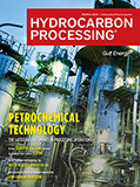Octane
HP Impact: Global oil flows shift from West to East
By 2020, crude oil trade flows west of Suez will drop by 4.2 MM bpd, while crude flows east of Suez will rise by 4.7 MM bpd (Fig. 1), according to a recently published report from ESAI Energy. The pri..
HP Impact: UK consumers buying less fuel at the pump
In the last 10 years, average UK fuel prices have almost doubled, rising from 73.68 p/l to 136.26 p/l for unleaded gasoline, and 75.57 p/l to 142.39 p/l for diesel. The latest retail marketing survey,..
Evaluate challenges in meeting clean-fuel specifications with heavier crude
At a Saudi Aramco refinery, a revamp was planned for processing a different crude oil blend to meet Euro 5 diesel and gasoline specifications. The refinery, which processes semi-light crude oil, is sc..
EIA projects rising US domestic oil production
Projected crude production is expected to average 7.3 million bpd in 2013 and 7.9 million bpd in 2014. EIA expects total consumption to rise slightly over the next two years to an average of 18.7 million bpd.
US lawmakers scrutinize role of ethanol credits in gasoline price spike
The price of credits used by refiners to meet federal ethanol blending requirements has risen more than 1,000% in recent weeks. The heightened volatility in this normally sleepy market has raised concerns that it is a factor in the recent rise in the price of gasoline.
Improve benzene control
The US Environmental Protection Agency (EPA) issued the Mobile Source Toxics (MSAT) Rule on February 26, 2007 (40 CFR Parts 59, 80, 85 and 86). This rule required refiners to reduce the average benzen..
HP Viewpoint: Refiners have a new learning curve with shale oil
We’ve all heard the news reports: “Shale resource developments have the potential to make the US energy independent for the first time since 1952.” The long-term impact of shale resourc..
HP Brief: Brief
Galveston Bay refineryMarathon Petroleum has closed its transaction with BP to purchase several assets, including the 451,000-bpd refinery located in Texas City, Texas. The refinery will be renamed an..
HP Industry Perspectives: EU leans forward on clean-fuel strategies
In late January 2013, the European Commission (EC) announced ambitious measures to ensure the buildup and standardization of alternative fueling stations across Europe. Much of the earlier EC policy i..
Catalyst news
New step-out catalyst for ULSD and hydrocracker pretreatHaldor Topsøe has announced an improved catalyst preparation technology. In hydrocracking pretreatment and high-pressure ULSD services, the..

- China's March jet fuel exports jump 77.4% from a year earlier 4/18
- Nigeria strikes deal with Shell to supply $3.8-B methanol project 4/18
- Singapore fuel oil stockpiles rebound to 8-week high on higher imports 4/18
- Clariant launches new CATOFIN 312 propane dehydrogenation catalyst 4/18
- Solvay inaugurates new blowing agent production unit in Rosignano, Italy 4/18
- Meridian Energy Group’s Davis Refinery Project in North Dakota (U.S.) will be the world’s first net-zero carbon refinery 4/17




